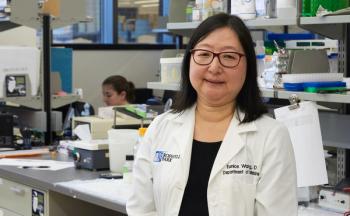
Whole Exome Sequencing Identifies Distinct Profile of Transformed SCLC
Key Takeaways
- Transformed SCLC from EGFR-mutated LUAD shows a unique mutational profile, complicating treatment approaches and highlighting the need for tailored therapies.
- Whole exome sequencing revealed transformed SCLC shares more genomic similarities with primary LUAD than de novo SCLC, maintaining EGFR mutations.
Researchers hope that identifying the genomic alterations specific to transformed small cell lung cancer (SCLC) can help drive improvements in personalized treatments for these patients.
In cases where epidermal growth factor receptor (EGFR)-mutated lung adenocarcinoma (LUAD)—a type of non–small cell lung cancer (NSCLC)—transforms into
Transformed SCLC carries significant unknowns and challenges with treatment despite occurring at a higher rate than other transformations occurring from NSCLC. One previous study found that disease transformation to SCLC occurred across 2.2% of 2600 cases, a higher proportion than that observed for other NSCLC subtypes (0.6%).
“Although transformation from LUAD to SCLC is not the only variant observed, it is most frequently seen following EGFR-[tyrosine kinase inhibitor] therapy,” wrote the researchers. “Similar transformations have also been noted in patients with ALK and ROS1 mutations. However, the origin of histological transformation to SCLC has always been a subject of debate. Yet there is no consensus on the treatment of transformed SCLC.”
Uncertainty over the optimal treatment approach stems from a gene mutation profile that falls in the middle of primary LUAD and de novo SCLC, with no clear direction in treatment guidelines, explained the researchers. With inconclusive treatment guidance and varying findings from clinical trials, the prognosis of transformed SCLC remains poor, though several recent studies have suggested some promising options.
The researchers of the new study aimed to enhance the understanding of transformed SCLC by performing whole exome sequencing and comparing genomic information across tissue samples of transformed disease and de novo disease, identifying specific genomic alterations driving the transformation.1
The group examined 5 tissue samples of LUAD prior to SCLC transformation, 12 tissue samples of disease transformed to SCLC following EGFR-targeted treatment, and 18 tissue samples of de novo SCLC.
Between the 3 tissue sample types, the researchers found more similar patterns of mutations among those of transformed SCLCs and primary LUADs. For example, all cases of transformed SCLC maintained the EGFR mutation from pre-transformed LUAD. Meanwhile, an EGFR mutation was present in just 3 (17%) of the de novo SCLC samples.
“Our results also showed transformed SCLCs exhibited a large number of [copy number variations (CNV)] losses as in de novo SCLCs and contained partial CNV gains as seen in primary LUADs,” explained the researchers. “Meanwhile, transformed SCLCs exhibited a large number of [uniparental disomy]. These indicate that SCLC may have evolved from a lineage evolution rather than selection through EGFR-TKI treatment.”
There were suggestions that TP53 mutations are acquired during the transformation, though the researchers noted that while important, these mutations are not required for SCLC transformation. The mutation rates of TP53 were 60% (n = 3) in primary LUAD, 70% (n = 7) in transformed SCLC, and 89% (n = 16) in de novo SCLC.
Their findings were confirmed as the researchers compared their transformed SCLC tissue samples with those of 3 previously published cohorts of de novo SCLC. They found comparable rates of TP53 mutations among all groups with a significantly higher presence of EGFR mutations among transformed SCLC samples.
Loss of RB1 was also identified as important, though not needed for transformation, with less obvious differences across tissue types. RB1 loss rates were observed in 40% (n = 2) of primary LUAD samples, 30% (n = 3) of transformed SCLC samples, and 50% (n = 9) of de novo SCLC samples.
"In conclusion, the genomic characterization of transformed SCLC presented in our study contributes to a deeper understanding of this disease subtype and may pave the way for more effective diagnostic and therapeutic approaches in the management of EGFR‐mutated lung cancers that undergo transformation," the authors wrote, "potentially improving patient outcomes in this challenging disease context."
References
- Tan J, Zhao D, Wang Q, et al. Whole exome sequencing study identifies distinct characteristics of transformed small cell lung cancer with EGFR mutation compared to de novo small cell and primary non-small cell lung cancers. Cancer Med. 2025;14(7):e70838. doi:10.1002/cam4.70838
- Zhang C-Y, Sun H, Su J-W, et al. A potential treatment option for transformed small-cell lung cancer on PD-L1 inhibitor-based combination therapy improved survival. Lung Cancer. 2023;175:68-78. doi:10.1016/j.lungcan.2022.11.016
Newsletter
Stay ahead of policy, cost, and value—subscribe to AJMC for expert insights at the intersection of clinical care and health economics.








